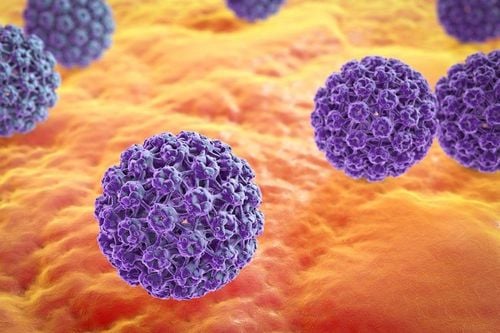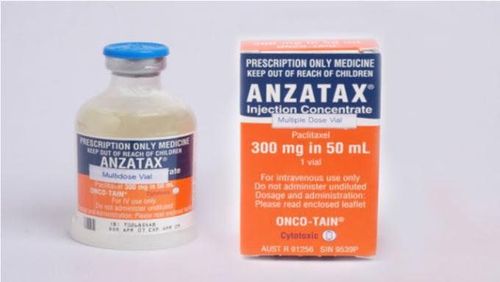This is an automatically translated article.
Cervical cancer occurs when abnormal cells grow and spread in the cervix. Most cases of this disease are caused by the HPV virus. If detected early, the disease is highly curable.
1. What causes cervical cancer?
The leading cause of cervical cancer is HPV. Human papillomavirus (HPV) is a large group of viruses. There are about 40 types of HPV that can infect the genital area, and some have a high risk of causing cervical cancer.
Genital HPV infections usually go away on their own. However, chronic HPV infection can cause changes in the cells of the cervix and even lead to cancer. Worldwide, more than 90% of cervical cancers are caused by HPV infection.
HPV infections often have no symptoms. Some types of HPV can cause genital warts, but these are not the strains that cause cervical cancer. It is important that genital warts do not turn cancerous even if left untreated. Dangerous strains of HPV can stay in the body for years without causing any symptoms.
HPV is common among people who have had sex. Because HPV can silently exist, it's likely that you've been carrying the virus for many years since you started having sex. Condoms can reduce the risk of HPV infection but cannot provide complete protection. The risk of cervical cancer HPV is higher in people who are exposed to secondhand smoke, have many children, use oral contraceptives for a long time, have many sex partners, have HIV, or have a weakened immune system. .

HPV là nguyên nhân hàng đầu gây ung thư cổ tử cung hiện nay
2. Common symptoms of cervical cancer
When cervical cancer cells first form, the disease usually doesn't cause any symptoms. As HPV cervical cancer progresses, symptoms may include:
Abnormal vaginal discharge Vaginal bleeding between periods Bleeding after menopause Bleeding or pain after giving birth sexually active
3. How to diagnose cervical cancer?
3.1 Pap test The Pap test is the method used to detect cervical cancer early. A sample of cervical tissue can help your doctor detect abnormal cells before cancer appears. Women should start having a Pap test at age 21 every 3 years. Between the ages of 30 and 65, women should have a Pap test and an HPV test every 5 years. However, women who are at higher risk may need more frequent testing (as advised by their doctor).
Note: You still need a Pap test after getting the HPV shot because it can't completely prevent cervical cancer.
If the Pap test results show a small abnormality, you may need to have the test repeated. Your doctor may recommend a colposcopy to look at the cervical tissue and take a tissue sample for a biopsy. If the abnormal cells are precancerous, they are removed. Current treatments are very successful in preventing precancerous cells from progressing to cancer.
3.2 HPV DNA test In some cases, the doctor may recommend that the patient perform an HPV DNA test in addition to the Pap test. This test helps check for the presence of strains of HPV. It can be used in combination with the Pap test to screen for cervical cancer in women over 30 years of age. In addition, this method may also be recommended for women of all ages after an abnormal Pap test result.
3.3 Biopsy A biopsy involves taking a sample of cervical tissue for laboratory examination. Your doctor will examine the tissue sample for abnormal changes, precancerous cells, and cancer cells. In most cases, the biopsy will take place at the same time as the colposcopy. A cone biopsy allows the doctor to perform a pathology, examining abnormal cells beneath the surface of the cervix. However, this test may require anesthesia.

Hiện nay có nhiều biện pháp khác nhau có thể chẩn đoán ung thư cổ tử cung
4. Stages of cervical cancer
The stages of the disease include:
Stage I: The cancer has spread beyond the lining of the cervix but it is still only in the uterus; Stage II: Cancer has spread beyond the cervix and uterus, possibly to nearby tissues; Stage III: The tumor has spread to the lower part of the vagina, which can make it difficult for the patient to urinate; Stage IV: The final stage, when the cancer has spread to nearby organs and many other parts of the body. Depending on the stage of the disease, you will be consulted by your doctor on different ways to treat cervical cancer to ensure the best health.
5. Measures to reduce the side effects of cervical cancer treatment
Cervical cancer treatments can make you tired or lose your appetite. However, it is important that you consume enough calories to maintain a healthy weight. Therefore, it is best to consult a nutritionist to learn about good eating habits during cancer treatment.
In addition, maintaining a habit of exercise is also very important. You should do light exercise to increase energy, reduce feelings of nausea and stress. You can talk to your doctor to choose the form of exercise that is right for you.
6. Cervical cancer and fertility, life expectancy
Treatment for cervical cancer usually includes a hysterectomy, which may include removing the ovaries so you won't be able to get pregnant in the future. However, if cancer is found early, you can still have children after treatment. A procedure that removes the cervix and part of the vagina while leaving most of the uterus intact to preserve your fertility.
The cure rate for cervical cancer is closely related to early detection. About 66% of women can live more than 5 years after being diagnosed and detected.

Phụ nữ vẫn có khả năng mang thai nếu phát hiện sớm ung thư cổ tử cung
7. Vaccines help prevent cervical cancer
Gardasil 9 vaccine can prevent HPV 16, HPV 18 and HPV 6, HPV 11. HPV 16 and HPV 18 are 2 strains closely related to cervical cancer; HPV 6 and HPV 11 cause genital warts. Girls and boys aged 9-14 years should get 2 doses of Gardasil 9 every 6-12 months. Children 15 years of age and older should receive 3 doses over 6 months. Vaccines can prevent up to 90% of cancers caused by HPV. In addition, Gardasil also prevents the infection of 5 other types of cancer-causing HPV.
This is a vaccine used to prevent, not treat, HPV infection. They are most helpful if you get vaccinated before you start having sex. The drug is recommended for people 9 - 26 years old.
Cervical cancer is a serious disease but can be prevented by up to 90% with adequate vaccination. Therefore, people of vaccination age should get the HPV vaccine to prevent this disease.
To meet the needs of women for gynecological cancer screening, Vinmec International Hospital currently provides a screening package and early detection of gynecological cancer, helping to detect 4 diseases early: Cancer cervical cancer, breast cancer, uterine cancer and ovarian cancer even if the patient has no symptoms.
The subjects who should use the Gynecological cancer screening and early detection package include:
Female customers, over 40 years old Customers wishing to be able to screen for pathology of breast-gynecological cancer (neck) uterus, uterus, ovaries) Customers at high risk of cancer – especially customers with a family history of breast cancer, gynecology Women of reproductive age, perimenopause Menopause and menopause Women are having symptoms of breast cancer, gynecological such as: pain in the breast, lump in the breast, bleeding outside of the menstrual period, abdominal pain, etc...
Please dial HOTLINE for more information or register for an appointment HERE. Download MyVinmec app to make appointments faster and to manage your bookings easily.













